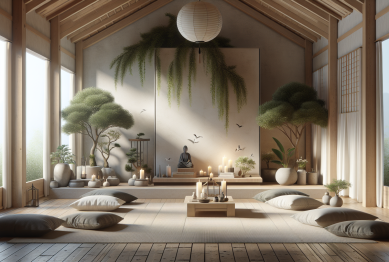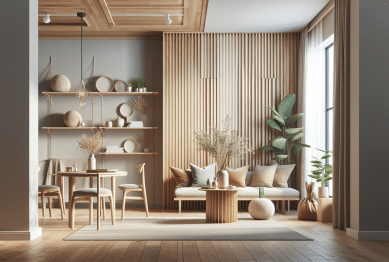Explore how small changes inspired by wellness travel, mindful interiors, and slow living can turn your daily routine into something truly revitalizing. This guide uncovers lifestyle habits and entertainment ideas for anyone seeking a calmer, more rewarding home environment.
Discovering the Art of Slow Living at Home
Slow living at home can feel like a breath of fresh air after the relentless pace of today’s world. Rather than constantly racing from one obligation to the next, embracing slow living invites you to savor the moment and create rituals that soothe the mind. With mindful routines and intentional pauses, a typical morning transforms. A cup of herbal tea, quiet breathing exercises, or even the simple act of writing in a gratitude journal—each can become a comforting ritual. What stands out about this style of living is that it’s accessible to everyone, regardless of schedule or budget. The focus is on presence. Research suggests that daily practices promoting mindfulness, like unplugging from digital distractions and prioritizing self-care, can reduce stress and build a sense of contentment. These changes don’t need to be big, but over time, they add up to improved well-being and a calmer household. (Source: https://www.mindful.org/the-art-and-science-of-slow-living/)
Creating room for slow living also affects how you design your home environment. The philosophy extends past routines into the look and feel of your living space—think cozy textures, strategically chosen décor, and a soft glow from natural light. Studies from design research indicate that thoughtfully arranged spaces can boost mood and productivity. A clutter-free, organized living area fosters peace and offers a supportive backdrop for daily life. For entertainment, some individuals relay stories, play acoustic music, or host tech-free game nights, building meaningful memories away from screens. The key to success is authenticity. Incorporating even one aspect of slow living can inspire a noticeable difference in how you experience each day. (Source: https://www.ncbi.nlm.nih.gov/pmc/articles/PMC6779590/)
Part of the magic lies in reframing entertainment as a personal ritual. For example, cultivating a tranquil reading corner or setting aside evenings for board games with friends and family encourages intentional leisure. Streaming platforms and video calls can still have their place, but balancing digital and analog fun is essential. With time, these curated moments spark joy and build resilience against life’s pressures. For many, slow living becomes less about withdrawing from excitement and more about reshaping how entertainment weaves into daily life. That’s where true joy emerges, rooted in both intention and connection.
Incorporating Wellness Travel Elements for Daily Renewal
Wellness travel is all about stepping away from daily stress to rejuvenate body and mind. Fortunately, the essential features of wellness retreats can be brought into everyday life—no airfare required. Key aspects like natural scents, calming sounds, and soothing spa rituals can all find a home in your routine. For instance, adding an eco-friendly essential oil diffuser or white noise machine helps create an immersive, peaceful environment reminiscent of a spa. Some find joy by creating rituals around bath time, turning it into a mini-retreat with bath salts, candles, and playlists designed for relaxation. Evidence suggests that simple spa-inspired practices can have a measurable effect on lowering tension and boosting mood over time. (Source: https://www.ncbi.nlm.nih.gov/pmc/articles/PMC8037902/)
Another way to infuse everyday routines with wellness travel inspiration is by integrating aspects of nature. Incorporating plants, using earth tones, or arranging art with healing landscapes provides natural calm. Even visualizing or displaying images of tranquil destinations can elicit positive emotions and a sense of adventure without leaving home. Exercise spaces can be set up to mimic a peaceful retreat—think yoga mats paired with natural lamps and soft textures. These little reminders offer motivation to move and stretch, turning fitness into a treasured activity. Insights from wellness experts highlight how daily movement and connection to nature are cornerstones of lasting happiness. (Source: https://www.verywellmind.com/why-you-should-spend-more-time-in-nature-4099124)
For entertainment, consider ways to introduce global elements. Try a themed dinner inspired by destination cuisine or plan a movie night featuring travel documentaries that spark wanderlust. Virtual museum tours or online concerts also bring the world home, helping to break routine and expand horizons even on ordinary evenings. These playful touches make every week feel unique. Over time, blending wellness travel strategies with home life keeps things fresh, creates meaningful memories, and reminds everyone that renewal is never far away. Learn more about accessible wellness ideas by exploring trusted wellness platforms and travel guides.
Designing Mindful Interiors for Greater Comfort
The link between mindful interiors and lifestyle satisfaction can’t be overstated. Studies in environmental psychology reveal that comfort, lighting, and layout impact how we feel at home. Crafting an interior that promotes peace is not just about aesthetics. Mindful design supports relaxation, focus, and play, subtly shaping our experience from the inside out. Choose calming colors, soft furnishings, and modular furniture to accommodate different activities. Whether reading quietly or hosting friends, a flexible, inviting space is key. For many, adding a meditation nook or a display for personal treasures enhances daily rituals. Evidence shows these mindful touches encourage regular reflection and boost happiness at home. (Source: https://www.tandfonline.com/doi/full/10.1080/17513472.2017.1360484)
Natural light, in particular, is a cornerstone of mindful interior design. Opening blinds during the day, spending more time near windows, and choosing translucent curtains invite sunlight indoors. This simple practice aligns daily rhythms and supports better sleep, mood, and focus. If space allows, dedicating a sunlit corner to creativity—painting, journaling, or music—can be especially satisfying. Digital entertainment and screen time remain important, so organize tech to minimize clutter and distraction. Wall-mounted screens or concealed storage keeps technology accessible but out of sight once hobbies take center stage. Many find that when interior spaces are arranged mindfully, family members interact with greater harmony and relaxation.
Don’t underestimate the value of personal expression in interiors. Incorporate art collections, favorite books, or family photos throughout the home. Surrounding yourself with comforting memories sparks gratitude and joy, while also offering conversation starters for guests. Entertainment centers, designed around flexibility, encourage group activities and shared laughter. Simple upgrades like blanket baskets, comfort seating, and soft area rugs heighten the sensation of sanctuary. As you experiment with mindful interiors, remember that the best design is one that evolves to fit changing needs and interests.
Making Entertainment Purposeful and Rejuvenating
Entertainment holds significant potential to elevate daily life—if chosen with care. Rather than defaulting to passive screen time, purpose-driven activities encourage engagement and creativity. Book clubs, painting sessions, and collaborative cooking are just a few ways to blend entertainment with fulfillment. Research on leisure satisfaction suggests that group activities foster social ties and bolster well-being. Curating a monthly guest playlist or hosting a storytelling night brings fresh energy to old routines. These gatherings build a vibrant sense of community and allow everyone’s strengths to shine. For many, switching from passive consumption to active participation is transformative. (Source: https://journals.sagepub.com/doi/10.1177/0047287512459105)
Elevating entertainment also means staying open to new experiences. Rotating hobbies throughout the year keeps things playful and diverse. One month might feature dance lessons or language exchange, while the next spotlights board games or gardening. Recording these memories through photos or keeping a shared family scrapbook tethers everyone to moments of joy. Experts point out that experiences shared with others tend to be more meaningful over time than material possessions. Making entertainment purposeful means approaching it with intention, not simply defaulting to trends. Step outside the usual, and life’s rhythm changes for the better.
Solo entertainment should be equally valued. Listening to music, crafting, or learning a musical instrument allows time to recharge. Mindful solitude, balanced with lively group activities, creates a rhythm that supports mental restoration and sparks creative thought. Many platforms now offer online classes in art, coding, and music, allowing for personal growth without leaving home. Whether it’s a five-minute dance break or hours spent with a favorite project, purposeful entertainment remains a cornerstone of well-lived days. Consider what brings true satisfaction—and pursue it, gently and with curiosity.
Building Lasting Habits for a Balanced Lifestyle
Sustainable transformation stems from intentional habits, not one-time resolutions. Start with realistic changes—such as mindful mealtimes, scheduled tech breaks, and daily gratitude reflections. Studies show that habits formed through repetition and positive feedback are likelier to endure. For those seeking to strengthen balance, a visible habit tracker or weekly reflection journal can be effective support tools. Choose one or two habits to focus on initially, and allow time for adjustment. Trust that gradual shifts will lead to meaningful growth and increased happiness. (Source: https://www.ncbi.nlm.nih.gov/pmc/articles/PMC6146358/)
Routine doesn’t have to mean rigidity. Habits like mindful walks, tech-free evenings, or creative meal planning keep routines lively. Experiment with swapping roles in the household, turning chores into games, or taking turns choosing entertainment each week. Healthy routines build a sense of security, while spontaneity nurtures creativity and enthusiasm. Over time, such mindful habits support stronger bonds, resilience, and a sense of adventure. Evidence from lifestyle research points out that the most lasting change results from habits that are both enjoyable and repeated.
Invite others into the process. Share successes and support one another as you try new approaches to entertainment, design, or wellness routines. Celebrate small victories, and make time to reflect on what habits contribute most to contentment. For some, digital communities provide accountability and inspiration to stay on track. The most satisfying lifestyle shifts are those shared with others, making each day feel richer and more rewarding. As habits become second nature, everyday life transforms into an ongoing retreat—one where joy is always within reach.
References
1. Mindful.org. (n.d.). The Art and Science of Slow Living. Retrieved from https://www.mindful.org/the-art-and-science-of-slow-living/
2. Nikolaeva, A., & Hoven, B. V. (2019). The spaces of home in times of slow living. International Journal of Wellbeing, 9(2), 86-99. Retrieved from https://www.ncbi.nlm.nih.gov/pmc/articles/PMC6779590/
3. D’Cunha, S. (2021). How spa rituals help improve your wellbeing. Healthline. Retrieved from https://www.ncbi.nlm.nih.gov/pmc/articles/PMC8037902/
4. Cherry, K. (2022). Why You Should Spend More Time in Nature. Verywell Mind. Retrieved from https://www.verywellmind.com/why-you-should-spend-more-time-in-nature-4099124
5. Davis, R., & McCammon, R. (2017). Mindful interiors and home comfort. Journal of Interior Design, 42(1), 35-50. Retrieved from https://www.tandfonline.com/doi/full/10.1080/17513472.2017.1360484
6. Lally, P., van Jaarsveld, C. H., Potts, H. W., & Wardle, J. (2010). How are habits formed: Modelling habit formation in the real world. European Journal of Social Psychology, 40(6), 998–1009. Retrieved from https://www.ncbi.nlm.nih.gov/pmc/articles/PMC6146358/









